Tokyo DisneySea
 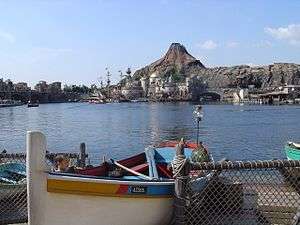 Mount Prometheus, the icon of the Tokyo DisneySea | |
| Location | Tokyo Disney Resort, Urayasu, Chiba Prefecture, Japan |
|---|---|
| Coordinates | 35°37′36″N 139°53′17″E / 35.62667°N 139.88806°ECoordinates: 35°37′36″N 139°53′17″E / 35.62667°N 139.88806°E |
| Theme | Nautical, exploration and adventure |
| Operated by | The Oriental Land Company |
| Opened | 4 September 2001 |
| Area | 176 acres (71 ha) |
| Website | Tokyo DisneySea official website (English) |
| Tokyo Disney Resort |
|---|
| Theme parks |
| Resort hotels |
| Shopping, dining and entertainment |
| The Oriental Land Company |
Tokyo DisneySea (東京ディズニーシー Tōkyō DizunīShī) is a 176-acre (71.22 ha) theme park at the Tokyo Disney Resort located in Urayasu, Chiba Prefecture, Japan, just outside Tokyo.[1] It opened on 4 September 2001, at a cost of 335 billion yen.[2] Owned by The Oriental Land Company, which licenses Disney characters and themes from The Walt Disney Company, Tokyo DisneySea attracted an estimated 13.46 million visitors in 2016, making it the fifth-most-visited theme park in the world.[3] Tokyo DisneySea was the second theme park to open at the Tokyo Disney Resort and the ninth park of the twelve worldwide Disney theme parks to open. Tokyo DisneySea was the fastest theme park in the world to reach the milestone of 10 million guests, having done so in 307 days after its grand opening.[4] The previous record-holder was Universal Studios Japan 338 days after its opening.
Concept
Tokyo DisneySea has an overall nautical exploration theme to it. The idea for the park can be traced to a proposal to build a second theme park in Southern California called "Port Disney" in Long Beach, California, with the RMS Queen Mary as the main attraction.[5] The idea was scrapped after the company endured financial trouble with the Euro Disney project. Later the idea was passed on to the Oriental Land Company to expand their resort.
Layout
There are seven themed areas or "ports of call". The entrance to the park is Mediterranean Harbor, which opens up to six more nautically themed ports: American Waterfront, Lost River Delta, Port Discovery, Mermaid Lagoon, Arabian Coast, and Mysterious Island.[1]
Mediterranean Harbor
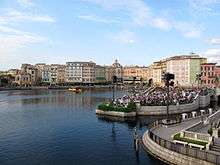

Mediterranean Harbor is the entrance "port-of-call" and themed as an Italian port city, with Venetian Gondolas that guests can board and ride.[1] Littered throughout the port are various shops and restaurants. Mediterranean Harbor's layout differs from the entry "lands" of other Disney parks as it is a large "V" shape rather than a main street that leads to a hub (as found in Disneyland's Main Street, U.S.A. or Disney's Hollywood Studios' Hollywood Boulevard"). To the right, the path leads to Mysterious Island, and to the left, the path leads to the American Waterfront. Built into the architecture of the port is Tokyo DisneySea Hotel MiraCosta; the hotel serves as a full-scale reproduction of the various buildings of Portofino and Venice's ports, and serves as the southern berm (or border) of the park. Mediterranean Harbor also features "Fortress Explorations", a large-scale interactive play area for guests that features exploration-themed activities and attractions. The nighttime show "Fantasmic!" premiered on 28 April 2011 as part of the park's 10th anniversary celebration.
Mysterious Island
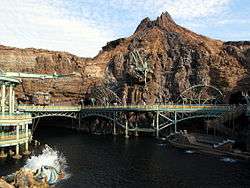
Mysterious Island is a "port-of-call" within Mount Prometheus, the giant volcano that is the park's centerpiece and most prominent feature. It relies heavily on the storytelling of Jules Verne and, specifically, the mythology of the volcano fortress mentioned several times in the books called "Vulcania". The Mount Prometheus ride employs technology similar to Epcot's Test Track.[1] The smallest "port of call", it nevertheless holds two of the more popular attractions: "Journey to the Center of the Earth", a thrill ride, and "20,000 Leagues Under the Sea", a dark ride. While appearing to be a volcano on the water, Mysterious Island is not an island; it is built into the side of Mount Prometheus, which is part of the show building for the two attractions. The architecture in this port is of Victorian style.
Mermaid Lagoon

Mermaid Lagoon is home to the characters of The Little Mermaid. The facade is made to look like the Palace of King Triton and features seashell-inspired architecture. This "port of call" is mostly indoors and recreates the feeling of being underwater. Attractions include Flounder's Flying Fish Coaster; Scuttle's Scooters; Jumpin' Jellyfish; Blowfish Balloon Race; The Whirlpool; all of which are children's rides. Also in this area are Ariel's Playground, which is a children's playground and extensive walk-through attraction that recreates the various settings in the movie; and the Mermaid Lagoon Theater, which is home to 'King Triton's Concert', a musical show featuring live actors, large-scale puppetry and Audio-Animatronics that recreate the story of The Little Mermaid.
Arabian Coast
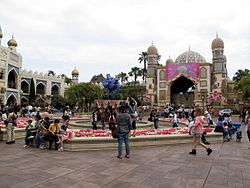
This is themed after Aladdin. It recreates an Arabian harbor combined with an "enchanted world from 1001 Arabian Nights". There are four attractions in the land: Sindbad's Storybook Voyage, an indoor dark ride boat ride whose art direction seems to be (at first glance) a variation on "It's a Small World" (with its own theme song, "Compass of your Heart", composed by Alan Menken); Caravan Carousel, a double-decker carousel that can hold over 190 passengers; Jasmine's Flying Carpets; and the Magic Lamp Theater, which houses a combined live-action/animatronic based magic show with a 3D movie featuring the Genie.
Lost River Delta

Located at the back of the park, the dominant structure in this "port of call" is the ruins of an ancient Aztec pyramid which houses the dark thrill ride, Indiana Jones Adventure: Temple of the Crystal Skull. Also in the Lost River Delta is the DisneySea Steamer Line which transports guests back to Mediterranean Harbor, 'Out of Shadowland', a live theatrical show that follows Mei, a young girl lost in a world of shadows who finds confidence and strength through her sojourn there. Furthermore, the Lost River Delta contains an Intamin roller coaster named Raging Spirits, which opened in 2005 and is similar to Indiana Jones et le Temple du Péril at Disneyland Park in Paris.
Port Discovery

This "port of call" is home to the fictional 'Marine Life Institute'; Port Discovery houses two attractions: Aquatopia, a boat ride that uses LPS tracking (the 'trackless' technology also used in Tokyo Disneyland's Pooh's Hunny Hunt) to move and spin through a lagoon amid waterfalls and whirlpools, and the 2 ft 6 in (762 mm) narrow gauge DisneySea Electric Railway, an overhead electric trolley that transports riders to and from the American Waterfront. On 12 May 2017, the land became home to Nemo & Friends SeaRider based on Finding Nemo/Finding Dory which replaced the former StormRider simulator.[6]
American Waterfront

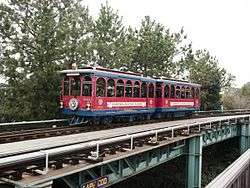

This "port of call" represents the northeastern seaboard of the United States in the early 20th century. It features two themed areas, an "Old Cape Cod" section, and a "New York Harbor" section. The land is dominated by a large passenger ship, SS Columbia, which is usually the site for various shows and events. Guests have the option of riding the area's "Big City Vehicles" which roam the streets of the area. It also features the 2 ft 6 in (762 mm) gauge DisneySea Electric Railway, which takes passengers from The American Waterfront to nearby Port Discovery. The port has a Broadway-themed theater which plays the show "Big Band Beat", which features 1940's-style swing jazz performed by a 12-piece band, as well as 20 singers/dancers.[1] The port's most popular attraction is the Tower of Terror, an elaborately themed free-fall E-ticket ride.[1]
Toy Story Mania is an interactive 4-D theme park attraction located at the American Waterfront in a new area called Toyville Trolley Park.[7] It is inspired by Disney Pixar's Toy Story. The attraction opened on 9 July 2012.[8] Guests wear 3-D glasses while riding spinning vehicles that travel through virtual environments based on classic carnival games. There are shooters on the vehicles to let guests to shoot targets in those 3-D games like "egg toss" and "balloon pop".[7]
Attendance
| 2008 | 2009 | 2010 | 2011 | 2012 | 2013 | 2014 | 2015 | 2016 | 2017 | Worldwide rank |
|---|---|---|---|---|---|---|---|---|---|---|
| 12,498,000[9] | 12,004,000[10] | 12,663,000[11] | 11,930,000[12] | 12,656,000[13] | 14,084,000[14] | 14,100,000 [15] | 13,600,000 [16] | 13,460,000[3] | 13,500,000[17] | 5 |
Awards
In 2002 Tokyo DisneySea won a Thea Award from the Themed Entertainment Association for the concept, design, and construction of the theme park. The award was presented at El Capitan Theater in Hollywood, California.[18]
Symbols
The park's two symbols are the DisneySea AquaSphere - a water fountain with a large model of the earth - in the entrance plaza, and the volcano, Mount Prometheus, in the center of the park.
See also
References
- 1 2 3 4 5 6 Rob Owen (9 October 2011). "Japan's Disneyland a little different". Pittsburgh Post-Gazette. Archived from the original on 10 January 2012. Retrieved 13 October 2011.
- ↑ "Tokyo DisneySea Project (1988 to 2001)". Oriental Land Company. Archived from the original on 18 May 2015. Retrieved 22 April 2015.
- 1 2 "TEA/AECOM 2016 Theme Index and Museum Index" (PDF). Themed Entertainment Association. 2016. Retrieved 6 June 2017.
- ↑ O'Brien, Tim. "DisneySea bolts to 10 million. (In Brief)." Amusement Business 15 July 2002: 8. General OneFile. Web. 21 April 2015.
- ↑ "Tokyo DisneySea". Theme Park Insider.
- ↑ "New "Finding Nemo" attraction coming to Tokyo DisneySea Park in Spring 2017, StormRider to close". Inside the Magic. Retrieved 20 May 2015.
- 1 2 "Toy Story Mania". Retrieved 16 September 2014.
- ↑ ""Cinderella" Attraction and Toy Story Mania! Coming to Tokyo Disney Resort". Joe's Tokyo Disneyland Resort Photo Site. 7 May 2009. Retrieved 16 September 2014.
- ↑ "TEA/AECOM 2008 Global Attractions Report" (PDF). Themed Entertainment Association. 2008. Archived from the original (PDF) on 2 March 2013. Retrieved 20 November 2012.
- ↑ "TEA/AECOM 2009 Global Attractions Report" (PDF). Themed Entertainment Association. 2009. Archived from the original (PDF) on 2 June 2010. Retrieved 20 November 2012.
- ↑ "TEA/AECOM 2010 Global Attractions Report" (PDF). Themed Entertainment Association. 2010. Archived from the original (PDF) on 19 July 2011. Retrieved 20 November 2012.
- ↑ "TEA/AECOM 2011 Global Attractions Report" (PDF). Themed Entertainment Association. 2011. Archived from the original (PDF) on 18 October 2015. Retrieved 20 November 2012.
- ↑ "TEA/AECOM 2012 Global Attractions Report" (PDF). Themed Entertainment Association. 2012. Archived from the original (PDF) on 8 April 2014. Retrieved 25 July 2013.
- ↑ "TEA/AECOM 2013 Global Attractions Report" (PDF). Themed Entertainment Association. 2014. Archived from the original (PDF) on 6 June 2014. Retrieved 6 June 2014.
- ↑ "TEA/AECOM 2014 Global Attractions Attendance Report Report" (PDF). Themed Entertainment Association. 2015. Archived from the original (PDF) on 26 June 2015. Retrieved 4 June 2015.
- ↑ "TEA/AECOM 2015 Global Attractions Attendance Report Report" (PDF). Themed Entertainment Association. 2016. Retrieved 3 June 2016.
- ↑ "TEA/AECOM 2017 Theme Index and Museum Index" (PDF). Themed Entertainment Association. 2017. Retrieved 17 May 2018.
- ↑ "Themed Entertainment Association Thea Awards". Themed Entertainment Association. 2002. Archived from the original on 19 December 2002. Retrieved 4 October 2009.
External links
| Wikimedia Commons has media related to Tokyo DisneySea. |